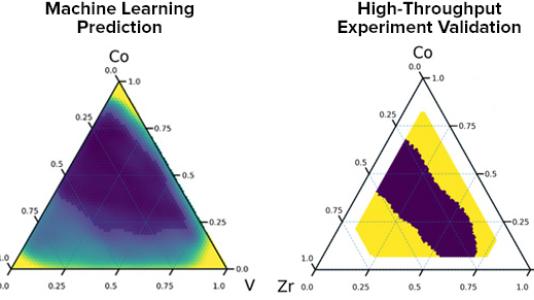
Scientific achievement
With more than a hundred elements in the periodic table, a large number of potential new materials exist to address the technological and societal challenges we face today; however, without some guidance, searching through this vast combinatorial space is frustratingly slow and expensive, especially for materials strongly influenced by processing. Argonne researchers, closely collaborating with other scientists from the U.S. Department of Energy (DOE), U.S. Department of Commerce, and several universities, recently trained a machine learning (ML) model on data from 30 years of metallic and mechanistic theories of glass formation, and used it guide high-throughput (HiTp) experiments to find a new system of metallic glasses in the Co-V-Zr ternary.
While the approach of iterative use of ML and HiTp experiments has led to rapid discovery of three new glass-forming systems, it has also provided us with a quantitatively accurate, synthesis method–sensitive predictor for metallic glasses that improves performance with use and thus promises to greatly accelerate discovery of many new metallic glasses. Argonne researchers believe that this discovery paradigm is applicable to a wider range of materials and should prove equally powerful for other materials and properties that are synthesis path–dependent and that current physiochemical theories find challenging to predict.
Significance and impact
Argonne researchers and other collaborators took advantage of a system at SLAC National Laboratory’s Stanford Synchrotron Radiation Lightsource(SSRL) that combines machine learning - a form of artificial intelligence where computer algorithms glean knowledge from enormous amounts of data - with experiments that quickly make and screen hundreds of sample materials at a time. This allowed the team to discover three new blends of ingredients that form metallic glass, and to do this 200 times faster than it could be done before, which was recently reported in Science Advances.
Research details
- Created a machine learning model that predicts whether a metal alloy forms a glass when sputtered
- Used the model to identify several glass-forming systems out of 2.4M alloys
- Validated the predictions with automated, high-throughput experimentation
http://advances.sciencemag.org/content/4/4/eaaq1566
This research was funded by the U.S. Department of Energy (DOE), U.S. Department of Commerce, and the National Science Foundation.
Argonne National Laboratory seeks solutions to pressing national problems in science and technology. The nation’s first national laboratory, Argonne conducts leading-edge basic and applied scientific research in virtually every scientific discipline. Argonne researchers work closely with researchers from hundreds of companies, universities, and federal, state and municipal agencies to help them solve their specific problems, advance America’s scientific leadership and prepare the nation for a better future. With employees from more than 60 nations, Argonne is managed by UChicago Argonne, LLC for the U.S. Department of Energy’s Office of Science.
The U.S. Department of Energy’s Office of Science is the single largest supporter of basic research in the physical sciences in the United States and is working to address some of the most pressing challenges of our time. For more information, visit https://energy.gov/science.